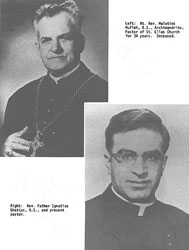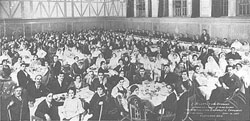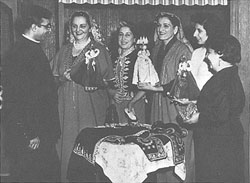|
CHAPTER 16 St. Elias Melkite Byzantine Catholic Church The religious descendency of St. Elias Melkite Byzantine stems from conversion to Christianity by Jesus Christ and the Apostles. The origin of this Eastern rite Catholic sect dates back to the Church of Antioch. Known in the dioceses of Jerusalem, Amman and Galilee as the Greek Catholiques, the Melkites trace their name to the Ecumenical Council of Calcedon in A.D. 451. Derided by the main Antiochian body they were identified with the "Melko" or emperor. Following the Emperor, they were the only Christians in the Middle East who upheld the doctrine of two natures in Christ. The Melkite form of church government is identical with the autocephalous Orthodox Church, its bishops being elected by the Holy Synod which meets annually. This Synod compares to the Roman Curia and the College of Cardinals of the Latin Church. However, until the establishment of the Melkite Apostolic Exarchate of the United States in 1966, all Melkite parishes were under the jurisdiction of the local Latin rite Bishop. The Melkite rite is in communion with Rome. The Patriarch is the elected leader of the church. His full title is Patriarch of Antioch, Alexandria, and Jerusalem and All the East. When elected, he requests the Pope of Rome to receive him into communion. In Lebanon, offices of the Permanent
Synod are in Ain-Traz. In America, the diocesan offices for the United States are in Boston. The Melkites in America, like members of other eastern rites, had for years, until the Second Vatican Council, endured attempts, within and outside the rite, to introduce Latinization into their liturgy. The decree of the Second Vatican Council that "All members of the Eastern Churches should know and preserve their legitimate liturgical rite and their estab�lished way of life" restored for many Melkite churches the earlier practices of the church. "First Holy Communion" and Funeral Masses have been abolished in numbers of churches. The three "Sacraments in Initiation," Baptism, Confirmation and Holy Eucharist are administered by the priest to the infant in the same ceremony. While it was normal procedure in the Middle East to ordain married men into the priesthood, this practice is still prohibited in North America, as is the granting of divorce with permission to remarry. The North American diocese now includes 26 parishes, seven missions, and four monasteries, with 20,000 members in organized parishes, and another 50,000 who do not live near a Melkite church. The first American Melkite parish was that of St. Joseph in Lawrence, Massachusetts which was founded in 1896. Five years later, in December of 1901, the Reverend Basil Marsha of Zahle, Lebanon, visited Cleveland and encouraged a number of the early Cleveland families to organize a Melkite parish in Cleveland. The first Melkite Byzantine Liturgy in Cleveland was celebrated by Father Marsha on Christmas Day in the Chapel of St. Joseph's Church on Woodland Avenue and East 23rd Street. This small group of Melkites
continued to attend Mass celebrated by Father Marsha at St. Joseph's until 1903 when a chapel at St. John's Cathedral was made available to them. In 1903, they formed the St. George Society with the purpose of founding a parish of their own. Salim Caraboolad was elected its first president. In 1906, Joseph Jalylatie offered the use of a building at 2231 East 9th Street, which was converted into a church, and Bishop Ignatius Horstmann named Father Marsha the pastor of this Melkite community. This church was the first Melkite church west of New York and the third to be established in America. For a number of years it served the entire Lebanese-Syrian community, until each rite could establish churches of their own. As Father Marsha visited cities throughout the United States and Canada, Father Abraham Istaphan of Jennin, Syria, cared for the needs of the Cleveland parish. Plans continued for the purchase of a suitable church building and a number of families pooled their resources to bring to reality their hopes for an established church. The names of some of these founding families were: Abdou, Abraham, Aftoora, Anter, Caraboolad, Jaber, Jalylatie, George, Hashem, Karam, Kassouf, Macron, Maloof, Mansour, Nasrallah, Nyme, Otto, Tuma, Zarzour, Zegiob and Zlaket. Two houses on Webster Avenue, at 1225 and 1227, were purchased on November 5, 1907, and remodeled into a church and a priests' residence. Bishop John Farrelly dedicated the church in April of 1908. In the earlier years, the parish was known as the "Church of the Syrian Catholics" and was at times called "The Church of the Savior for the Syrian Catholics." When the parishioners worshipped at the little building on East 9th Street, they called their church the "Church of St. Basil for the Syrian Catholics."
Since many of these parishioners were originally from the Lebanese towns of Zahle and Khirbet Kanafar where the churches were dedicated to St. Ellas, the Prophet, it was decided to call the new church on Webster St. Elias Church, the name it has borne since 1908. The first wedding in St. Elias on Webster was that of Saide Moshe Anter and Sa'aman (Sam) Heikell Macron in May of 1908. The first child to be baptized in the new church was Fuad Elias Boutros Nyme. Upon the return of Father Marsha to his homeland in 1921, Bishop Joseph Schrembs of the Diocese of Cleveland appointed Rev. Malatios Mufleh pastor, a post he held until 1955, except for a one-year temporary assign�ment in Connecticut. Father Mufleh was convivial and outgoing, a good mixer who enjoyed a one-to-one relationship with his parishioners. He had a voice that rang pure and clear in the chanting of the liturgy in the little white church on Webster Avenue, a hand that was quick to cuff a restless schoolboy, or pull the curl of a dark-eyed, shy, little girl. A cigar was always clamped firmly in a mouth nearly hidden by a heavy black beard, which he refused to shave for years, much to the fury of some of his westernized parishioners. In the difficult years of transition with the church still accountable to the Latin Diocese, and parishioners demanding western innovations. Father Mufleh led the parish with a spirit of compromise, good humor and patience. He encouraged students in the Catholic high schools to conduct Catechism classes for young first communicants, nonchalantly accepting the preparation for the ceremony. He alone recognized that this was really a Second Communion, having, himself performed the first when he baptized these children. "Well, it's all right," he would reason, "their mothers want them to wear a white dress and veil
and new white suits -- they want to have something special here in the church, so what harm." On confirmations he was equally amenable. "Well, if this child was confirmed at baptism, can it harm him to renew this dedication to the Holy Ghost? And is it not better to include him with all his American classmates when the bishop slaps their faces?" In the earliest years of his pastorate, he encouraged the formation of clubs and organizations, one of the first being the St. Elias Ladies' Guild in 1923. This group was a re-organization of one which had been started in 1915. A bazaar held in 1924 netted over $2,200.00, no mean sum for a small group of beginners in club work. Father Mufleh early recognized the effectiveness of a committed women's organization and as the group broadened their activities, he encouraged them to continue in community and civic involvement. One of the highlights of their long record was the participation as a unit in the International Eucharistic Congress which was held in Cleveland in 1935. Asked to attend the nation�ality procession in native dress, the women decided that gowns represent�ative of their early Christian rite would be most suitable. One of their members, Jennie Bowab Haddad, designed a long "thob" reminiscent of that worn by Mary the mother of Jesus, whom these women claimed as a daughter of Syria. The gown was of white silk crepe, its long wide sleeves lined with a deep cuff of blue and its flowing fullness girdled with a gold silk cord. A long veil, a mantille, of white chiffon completed the costume. On the day of the procession, more than a hundred women -- mothers with their teenage and married daughters, and old grandmothers taking slow and painful steps, marched in procession at the Cleveland Stadium, thousands of eyes upon their Holy Land dress.
|
St. Elias Church . . . Then and Now From "Our Celebration" 70th Anniversary of the Founding of St. Elias Church |
||
|
||
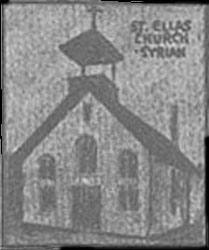 Webster Street Church | 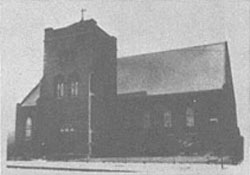 Scranton Avenue Church |
|
|
||
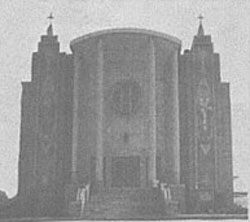 Memphis Avenue Church |
||
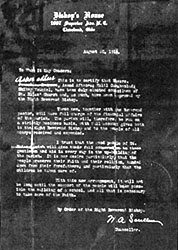 |
Below: The New St. Elias -- Where East meets West. | |
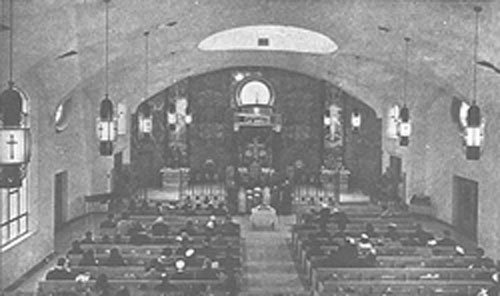
|
||
